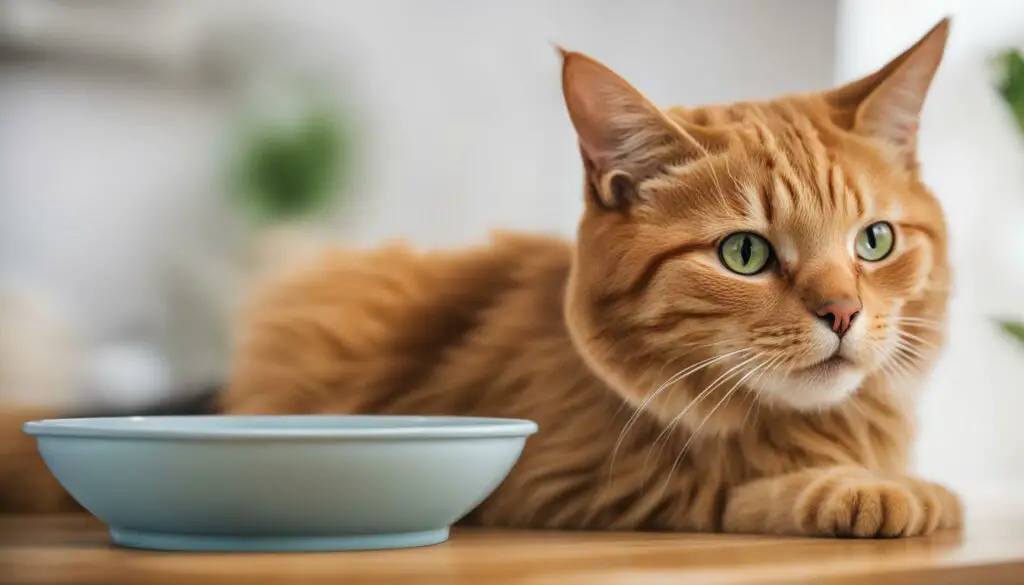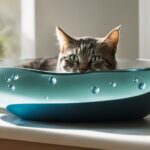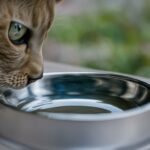Feline acne is a common skin condition that affects cats, primarily around the chin and lip margins. The exact cause is unknown, but it is believed to be triggered by factors such as increased production of sebum, viral infection, allergies, and contact hypersensitivity. Certain diseases and environmental factors can also increase the likelihood of feline acne. The signs of feline acne include thick, red, and crusty skin on the chin, visible clogged hair follicles, and the possibility of bacterial infections. Treatment should be provided by a veterinarian and may include shaving the affected area, cleaning with antiseptic solutions, lancing and draining abscesses, and the use of topical and/or oral medications.
Key Takeaways:
- Feline acne is a common skin condition that affects cats primarily around the chin and lip margins.
- The exact cause of feline acne is unknown, but it is believed to be triggered by factors such as increased sebum production, viral infection, allergies, and contact hypersensitivity.
- Treatment for feline acne should be provided by a veterinarian and may involve shaving the affected area, cleaning with antiseptic solutions, lancing and draining abscesses, and the use of topical and/or oral medications.
- Prevention and management of feline acne may involve grooming habits, changing food and water bowls, controlling allergies, and long-term topical therapy.
- Veterinarians play a crucial role in diagnosing, treating, and preventing skin conditions in cats, including feline acne.
What Causes Feline Acne?
Feline acne is a common skin condition in cats, primarily affecting the chin and lip margins. While the exact cause of feline acne is not fully understood, several factors have been identified as potential triggers. Viral infections, such as those associated with the upper respiratory tract, have been shown to increase the likelihood of feline acne. Increased production of sebum, an oily substance produced by the skin’s sebaceous glands, can also contribute to the development of acne by clogging hair follicles. Allergies, including contact hypersensitivity, as well as certain diseases, can further increase the risk of feline acne.
In households with multiple cats, it is possible that a common trigger or environmental factor may be responsible for the development of chin acne. Studies have shown that feline acne can be contagious between cats in certain situations. While the exact mechanism is not fully understood, this suggests that there may be a viral or environmental trigger involved in the development of feline acne.
In summary, the causes of feline acne are multifactorial and may involve viral infections, increased sebum production, allergies, and contact hypersensitivity. Additional research is needed to fully understand the underlying mechanisms and identify effective prevention and treatment strategies.
| Possible Causes of Feline Acne | |
|---|---|
| Viral infections | Upper respiratory tract infections can increase the likelihood of feline acne. |
| Increased sebum production | Excess production of sebum can clog hair follicles and contribute to the development of acne. |
| Allergies | Various allergies, including contact hypersensitivity, can increase the risk of feline acne. |
| Contact hypersensitivity | Exposure to certain substances or materials can trigger an allergic reaction and lead to the development of acne. |
What Are the Signs of Feline Acne?
Feline acne is a skin condition that primarily affects the chin region of cats. Recognizing the signs of feline acne is crucial for early detection and prompt treatment. The most common signs include:
- Thick, red, and crusty skin on the chin
- Visible clogged hair follicles
- Possible bacterial infections
When examining a cat with feline acne, you may notice the presence of dark lesions or spots under the skin, which indicate clogged hair follicles. In some cases, there may be discharge or fluid on or around the chin. It’s important to note that feline acne is generally not itchy or painful unless it becomes severe or if there are additional infections or diseases present. Other clinical signs may be present if the cat has underlying conditions like ringworm, which can cause circular, crusty hair loss.
It’s essential to consult a veterinarian for a proper diagnosis and treatment plan if you suspect your cat has feline acne. They can provide appropriate guidance and recommend a tailored approach based on the severity of the condition and any underlying diseases that may be contributing to the acne.
| Signs of Feline Acne | Description |
|---|---|
| Thick, red, and crusty skin on the chin | This is the most common sign of feline acne, with the chin area appearing inflamed and covered in thick, crusty skin. |
| Visible clogged hair follicles | Dark lesions or spots under the skin indicate clogged hair follicles and are a characteristic feature of feline acne. |
| Possible bacterial infections | Feline acne can sometimes lead to bacterial infections, which may present as pus-filled abscesses or discharge. |
Treatment for Feline Acne: Veterinary Care and Medications
Feline acne can be effectively treated with the help of veterinary care and appropriate medications. As an experienced veterinarian, I have successfully managed numerous cases of feline acne by employing various treatment techniques. The goal of treatment is to alleviate symptoms, promote healing, and prevent recurrences.
One of the initial steps in treating feline acne is shaving the affected area. By removing the hair around the chin, it becomes easier to clean and treat the affected skin. Cleaning the damaged skin with antiseptic solutions is essential for preventing bacterial infections and promoting healing.
In some cases, comedones or abscesses may develop and require lancing and draining to facilitate the healing process. Topical and oral medications are often prescribed to manage the condition effectively. Topical therapies such as antiseptics, antibiotics, and antifungals can be applied directly to the affected area. Oral antibiotics may be necessary for more severe cases to combat bacterial infections and reduce inflammation.
Table: Summary of Feline Acne Treatment Options
| Treatment Options | Description |
|---|---|
| Shaving the affected area | Allows better cleaning and treatment |
| Cleaning with antiseptic solutions | Prevents bacterial infections and promotes healing |
| Lancing and draining abscesses | Facilitates healing by removing accumulated fluids |
| Topical medications | Applied directly to the affected area to combat infections and reduce inflammation |
| Oral medications | Prescribed for more severe cases to address bacterial infections and inflammation |
It is important to note that treatment for feline acne should be provided by a veterinarian. They have the knowledge and expertise to accurately diagnose the condition and determine the most appropriate course of action. By seeking veterinary care, you can ensure that your feline companion receives the proper treatment and guidance for managing feline acne effectively.
<!–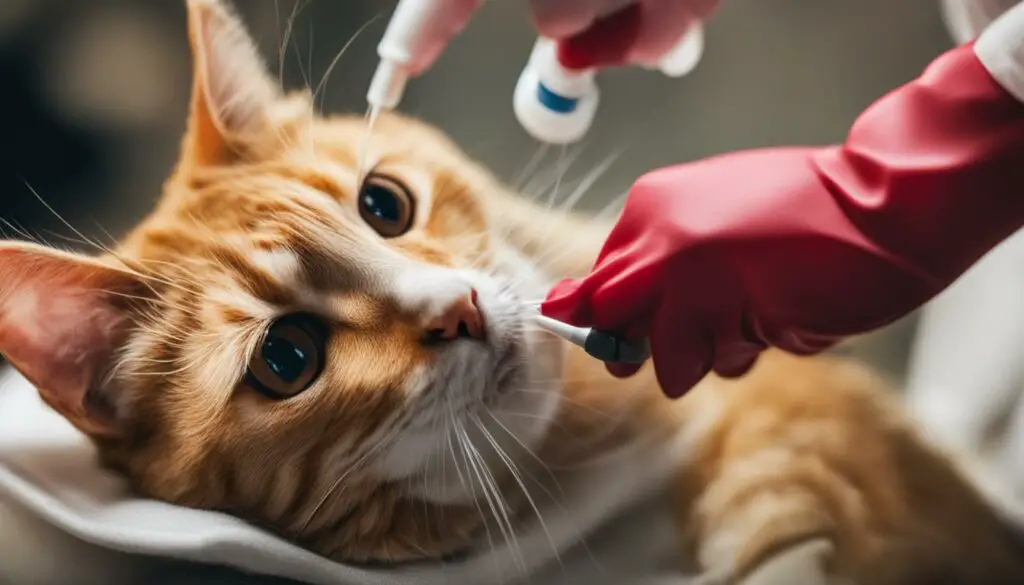 –>
–>
Can Feline Acne be Prevented?
Feline acne is a recurring condition that can be frustrating to manage. However, there are steps you can take to help prevent future outbreaks. Here are some preventive measures to consider:
- Grooming habits: Maintaining good grooming habits for your cat can help reduce the occurrence of feline acne. Regularly brushing your cat’s chin and face can help minimize the buildup of oil and bacteria that can contribute to acne breakouts.
- Changing food and water bowls: Consider switching from plastic bowls to ceramic or glass options. Plastic bowls can harbor bacteria and may contribute to the development of feline acne. Ceramic or glass bowls are easier to clean and less likely to cause allergies or skin problems.
- Controlling allergies: If your cat has known allergies, work with your veterinarian to identify and manage them effectively. Allergies can exacerbate feline acne, so controlling them can help prevent acne outbreaks.
- Long-term topical therapy: In some cases, long-term topical therapy may be necessary to maintain prevention. Your veterinarian may recommend cleansers or topical medications to keep your cat’s skin healthy and prevent future acne breakouts.
Feline Non-Parasitic Causes of Otitis and Ear Masses
Feline otitis and ear masses can be caused by various non-parasitic factors. It is important to understand these potential causes in order to effectively diagnose and treat these conditions in cats. Some of the common non-parasitic causes of feline otitis and ear masses include:
Feline Food Allergy
Food allergies can manifest as ear inflammation and itching in cats. When a cat ingests a food allergen, their immune system may react, leading to an inflammatory response. This can result in symptoms such as otitis and the formation of ear masses.
Atopy
Atopy refers to allergies caused by environmental factors such as pollen, dust mites, or mold. Cats with atopy may develop otitis and ear masses as a result of their immune system’s overreaction to these allergens. It is important to identify and avoid the specific allergens that trigger atopic reactions in cats.
Nasopharyngeal Polyps
Nasopharyngeal polyps are non-cancerous growths that can form in the nasal passages or middle ear of cats. These polyps can extend into the ear canal, causing blockages and leading to ear inflammation and the development of masses. Surgical removal is usually necessary to resolve the issue.
| Causes | Symptoms | Treatment |
|---|---|---|
| Feline Food Allergy | Ear inflammation and itching | Dietary changes, allergen avoidance |
| Atopy | Otitis, ear masses | Allergen identification, allergen avoidance, symptomatic treatment |
| Nasopharyngeal Polyps | Ear blockage, inflammation, masses | Surgical removal, symptomatic treatment |
It is essential to consult with a veterinarian for proper diagnosis and treatment of feline otitis and ear masses. They can perform thorough examinations, identify the underlying causes, and recommend appropriate treatment options. Early intervention and targeted management can help alleviate discomfort and improve the overall health and well-being of cats with these conditions.
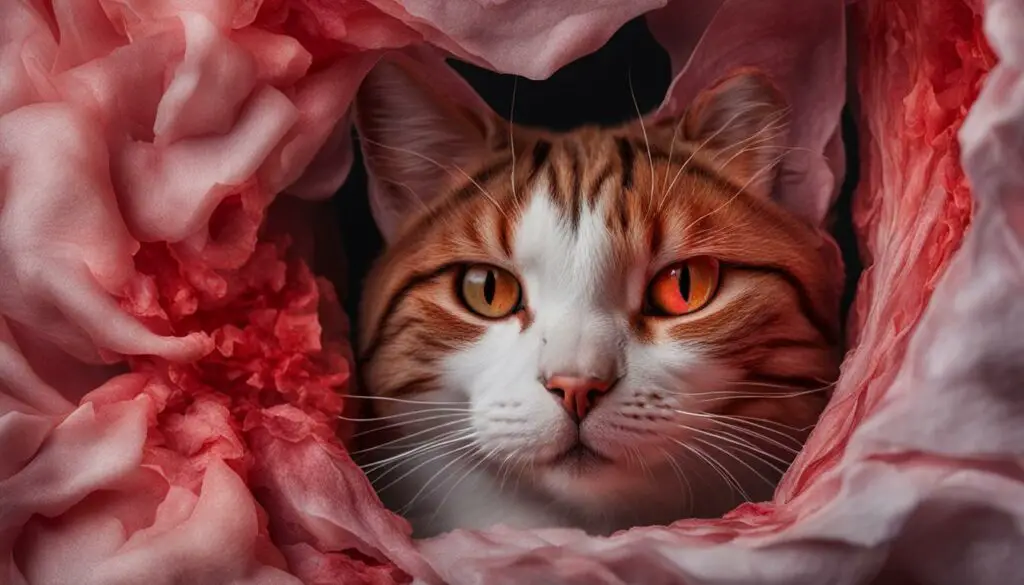
Feline Acne: An Idiopathic Disorder of Follicular Keratinization
Feline acne is a perplexing condition that affects cats of all ages, breeds, and genders. While the exact cause remains unknown, several underlying factors have been proposed. These include seborrhea, abnormal sebum production, changes in the hair cycle, viral infections (such as calicivirus and herpes virus), stress, chin trauma caused by excessive scent marking or scratching due to allergies, contact allergies from plastic food dishes, and poor grooming habits.
The condition usually begins with asymptomatic crusts and comedones on the chin and lower lip. As it progresses, it can lead to folliculitis/furunculosis, characterized by the formation of papules, pustules, cysts, nodules, and even cellulitis in severe cases. Feline acne is often pruritic, causing discomfort for affected cats. Regional lymphadenopathy may also occur.
The exact cause of feline acne remains unknown, but various factors have been proposed, including seborrhea, abnormal sebum production, viral infections, stress, chin trauma, contact allergies from plastic food dishes, and poor grooming habits.
When it comes to managing feline acne, identifying and addressing the underlying causes are crucial. Along with topical and/or oral medications prescribed by a veterinarian, it is important to focus on minimizing stress, improving grooming habits, and preventing further chin trauma. Environmental modifications, such as switching to ceramic or glass food dishes, can also help reduce the risk of contact allergies from plastic.
Treatment Options for Feline Acne
| Treatment | Description |
|---|---|
| Shaving the affected area | To facilitate better cleaning and treatment |
| Cleaning with antiseptic solutions | To reduce bacterial colonization |
| Lancing and draining abscesses | When necessary to promote healing |
| Topical medications | To alleviate symptoms and reduce inflammation |
| Oral medications | For more severe cases or when secondary infections are present |
While feline acne can be a challenging condition to manage, with proper veterinary care and attention to the underlying causes, it can be effectively controlled and improve the quality of life for affected cats.
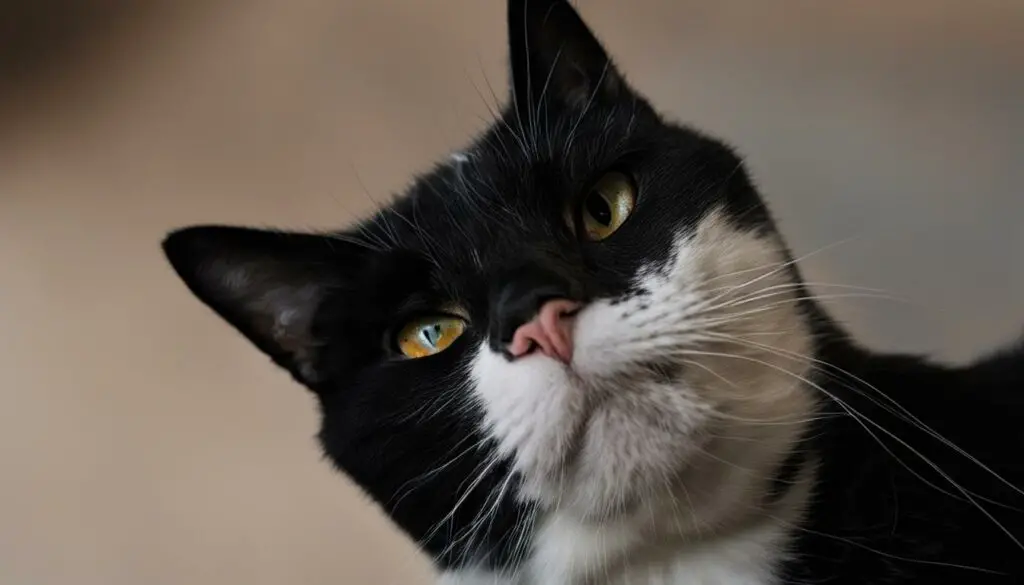
Allergic Dermatitis in Cats: Understanding the Pruritic Cat
If you notice that your cat is excessively grooming or scratching, it may be experiencing pruritic symptoms associated with allergic dermatitis. Allergic dermatitis refers to an allergic reaction on the skin that can occur due to various triggers such as flea allergy dermatitis, food intolerance, and atopy. It is essential to identify the underlying cause of allergic dermatitis in order to provide appropriate management and relief for your feline friend.
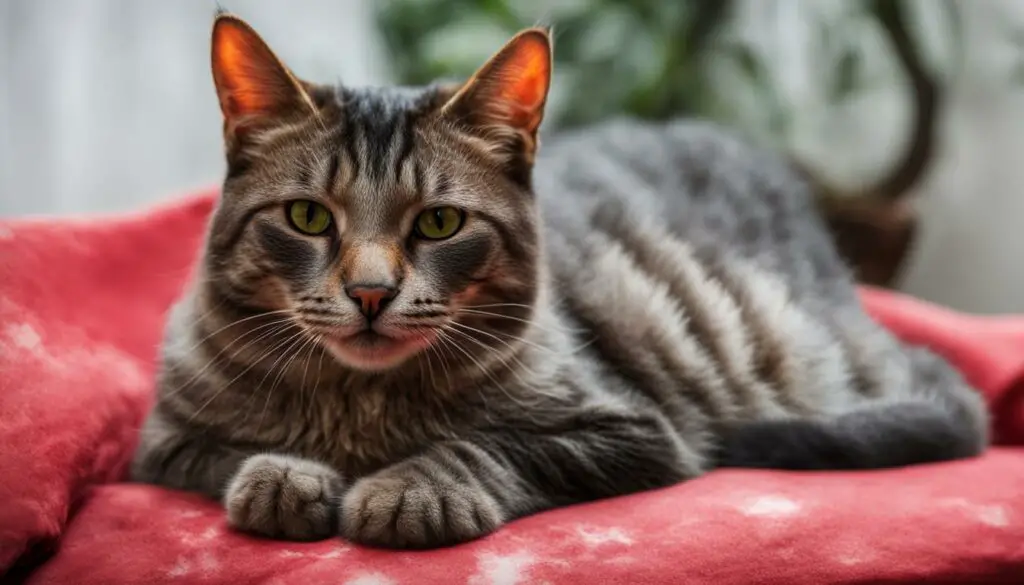
One of the common causes of allergic dermatitis in cats is flea allergy dermatitis. Even a single flea bite can trigger a severe allergic reaction in sensitive cats, leading to intense itching and discomfort. Regular flea prevention and control measures are crucial in managing and preventing flea allergy dermatitis. Another potential cause of allergic dermatitis in cats is food intolerance or hypersensitivity. Certain ingredients in your cat’s diet can trigger an allergic reaction, resulting in pruritic symptoms. Identifying and eliminating the problematic ingredient from your cat’s diet under the guidance of a veterinarian can help alleviate the symptoms.
Atopy is another common cause of allergic dermatitis in cats. It refers to an inherited predisposition to allergic reactions to environmental allergens such as pollen, mold, and dust mites. Cats with atopy may experience itching, redness, and inflammation on their skin. Environmental management, such as reducing exposure to allergens, and medical treatment prescribed by a veterinarian, can help manage the symptoms of atopy in cats.
When your cat exhibits pruritic behavior and shows signs of allergic dermatitis, it is essential to consult with a veterinarian. They can perform the necessary diagnostic tests to determine the underlying cause and recommend an appropriate treatment plan. With proper management and support, you can help your pruritic cat find relief and improve their overall well-being.
Plastic Food Bowls and Skin Problems in Cats
When it comes to our feline friends, their health and well-being are always a top priority. But did you know that the type of food bowl you use for your cat can potentially contribute to skin problems? Plastic food bowls, despite being commonly used, have been associated with the development of feline acne or chin acne. While scientific evidence specific to plastic allergies in cats is limited, it is important to consider alternative bowl options to avoid potential allergic reactions.
Allergic contact dermatitis caused by various components of plastic toilet seats has been reported in both humans and animals. Since cats spend a significant amount of time eating and drinking from their bowls, it is crucial to choose the right material that minimizes the risk of skin problems. Stainless steel bowls, on the other hand, have been associated with allergies in certain breeds of dogs. As a safer alternative, ceramic or sturdy glass bowls are often recommended for cats. These materials are less likely to cause allergies and can be easier to clean and maintain.
Cleaning the food bowls regularly is also important. Bacteria-laden slime can accumulate on the bowl’s surface, serving as a trigger for skin problems in cats. By cleaning the bowls regularly, ideally on a daily basis, you can help reduce the risk of skin issues. Additionally, shallow bowls are preferable as they minimize skin contact with the bowl surface, further promoting good hygiene.
Table: Comparison of Different Bowl Materials
| Bowl Material | Advantages | Disadvantages |
|---|---|---|
| Plastic | – Lightweight and affordable – Wide variety of colors and designs |
– Potential risk of allergic reactions – Can harbor bacteria – May scratch easily |
| Stainless Steel | – Durable and long-lasting – Easy to clean – Resistant to scratching |
– Allergic reactions in certain dog breeds – Can be noisy when touched |
| Ceramic | – Safer option for cats – Resistant to scratching – Easy to clean |
– Can break if dropped – Heavier compared to other materials |
| Glass | – Safer option for cats – Easy to clean – Resistant to scratching |
– Can break if dropped – Heavier compared to other materials |
By prioritizing your cat’s health and choosing the right food bowl material, you can help prevent skin problems such as feline acne. Consider switching from plastic or stainless steel to ceramic or glass bowls, and make sure to clean the bowls regularly to ensure good hygiene. When in doubt, consult with your veterinarian for personalized advice and guidance on preventing and managing skin conditions in your cat.
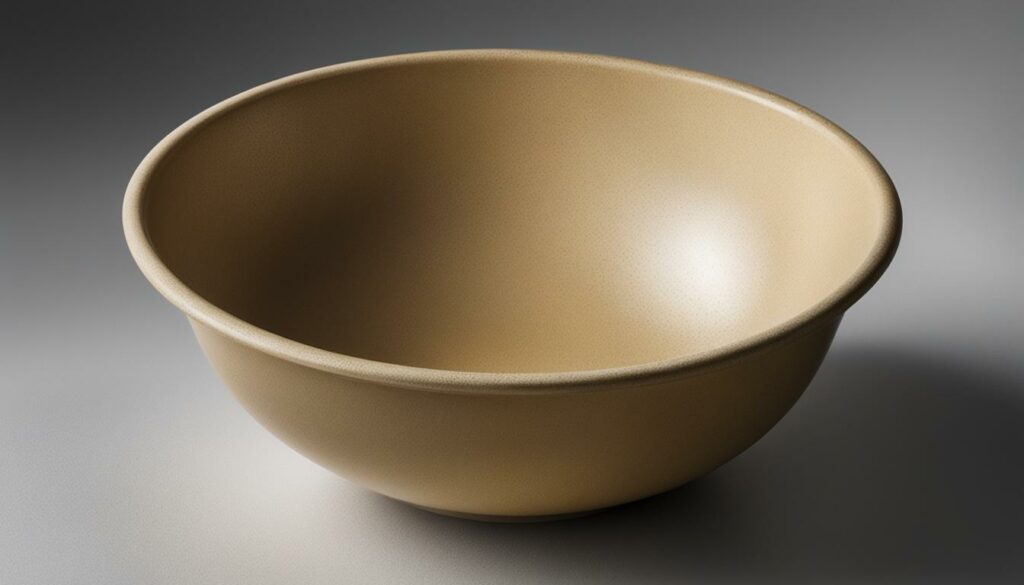
How to Prevent and Manage Chin Acne
Chin acne in cats can be managed effectively through a combination of preventive measures and proper management techniques. By taking proactive steps to minimize potential triggers and following recommended treatment protocols, pet owners can help keep their cats‘ chin acne under control.
Prevention Strategies
- Switching to ceramic or glass bowls:
- Cleaning bowls regularly:
Plastic and stainless steel bowls have been associated with allergies in cats. By using ceramic or glass bowls instead, you can reduce the risk of skin irritation and inflammation.
Regular cleaning of food bowls is essential to remove bacteria and prevent the accumulation of slime that can serve as a trigger for chin acne. Ideally, bowls should be cleaned daily to maintain proper hygiene.
Management Techniques
- Using benzoyl peroxide wipes:
- Seeking veterinary treatment:
Benzoyl peroxide wipes can be used to clean the affected chin area once or twice a day. These wipes help remove excess oil and bacteria, promoting a healthier skin environment.
In more severe cases of chin acne, veterinary treatment may be necessary. Your veterinarian can prescribe antibiotics, corticosteroids, and other topical or oral medications to help alleviate symptoms and promote healing.

It’s important to remember that each cat is unique, and what works for one may not work for another. By monitoring your cat’s condition and consulting with a veterinarian, you can develop a customized prevention and management plan that is tailored to your cat’s specific needs.
| Treatment | Description |
|---|---|
| Shaving affected area | Allows better cleaning and treatment of the affected chin area. |
| Cleaning with antiseptic solutions | Helps remove bacteria and maintain proper hygiene. |
| Lancing and draining abscesses | Facilitates healing and prevents further infection. |
| Topical and/or oral medications | Prescribed by a veterinarian to alleviate symptoms and promote healing. |
“Preventing and managing chin acne in cats requires a multi-faceted approach. By implementing preventive strategies, such as switching to ceramic or glass bowls and cleaning them regularly, pet owners can minimize the risk of skin problems. In more severe cases, seeking veterinary treatment and following prescribed medications is crucial for effective management. Each cat is unique, so it’s important to work closely with a veterinarian to develop a personalized plan that addresses your cat’s specific needs.”
With proper prevention and management, chin acne can be effectively controlled, allowing your cat to live a comfortable and healthy life.
Potential Allergies in Cats and Dogs
Allergies can be a common issue in both cats and dogs. Just like humans, our furry friends can develop allergies to various substances, including certain materials used in their everyday lives. While plastic allergies are relatively rare, they have been reported in both cats and dogs. Additionally, some pets may also have allergies to stainless steel bowls. To minimize the risk of allergies, it is recommended to consider using ceramic or glass bowls. These materials are less likely to cause allergic reactions and can be safer options for your pet’s overall health.
Cleaning your pet’s food bowls regularly is also important, regardless of the material used. Bacteria can accumulate in the bowls over time, which can potentially lead to skin problems or other related conditions. By cleaning the bowls regularly, you can help ensure proper hygiene and reduce the risk of allergies or other health issues.
When it comes to choosing the right bowls for your pet, it’s crucial to prioritize their health and well-being. Ceramic bowls and sturdy glassware are often recommended due to their durability and lower risk of allergies. These bowls can be easier to clean and maintain, providing a safe and hygienic feeding option for your pet. By selecting the right bowls and maintaining good hygiene practices, you can help prevent potential allergies and promote your pet’s overall health.
Potential Allergies in Cats and Dogs
- Cats and dogs can develop allergies to certain materials
- Plastic allergies have been reported in both cats and dogs
- Stainless steel bowls can also trigger allergies in certain breeds
- Ceramic and glass bowls are recommended as safer alternatives
- Regular cleaning of food bowls is important for proper hygiene
“Choosing the right bowls for your pet is essential for their health and well-being. Consider using ceramic or glass options to reduce the risk of allergies.”
To summarize, allergies in cats and dogs can be a concern for pet owners. While plastic allergies and stainless steel allergies are relatively rare, they can still occur in some cases. Opting for ceramic or glass bowls can help minimize the risk of allergies and promote your pet’s overall health. Regular cleaning of food bowls is crucial for maintaining proper hygiene and reducing the potential for skin problems or other related conditions. By taking these steps, you can provide your pet with a safe and comfortable feeding experience.
The Importance of Choosing the Right Bowls for Your Pet’s Health
When it comes to your pet’s health and well-being, every decision you make plays a crucial role. One often overlooked aspect is the choice of food bowls. The type of bowl you use can have a significant impact on your pet’s overall health, particularly when it comes to allergies and hygiene. It’s important to choose bowls that minimize the risk of skin problems and other related conditions.
Allergies are a common concern for many pets, and the material of the food bowl can play a role in triggering allergic reactions. Plastic bowls, for example, have been associated with the development of feline acne or chin acne. Some pets may also have allergies to stainless steel bowls. To reduce the risk of allergies, it’s recommended to opt for ceramic bowls or sturdy glassware, as they are less likely to cause allergic reactions.
Hygiene is another crucial factor to consider when choosing the right bowls for your pet. Plastic bowls, in particular, can become a breeding ground for bacteria if not cleaned regularly. Ceramic bowls and glassware are easier to clean and maintain, ensuring proper hygiene for your pet’s food and water. Regular cleaning of food bowls is essential to remove bacteria and prevent the accumulation of slime that can serve as a trigger for skin problems in cats and dogs.
By prioritizing the importance of choosing the right bowls for your pet’s health, you can help prevent allergies and maintain proper hygiene. Ceramic bowls and glassware are safer choices that minimize the risk of skin problems and allergic reactions. Regular cleaning of food bowls ensures your pet’s food and water are free from bacteria, promoting better overall health. Remember, every decision you make for your pet’s well-being matters, and choosing the right food bowls is no exception.
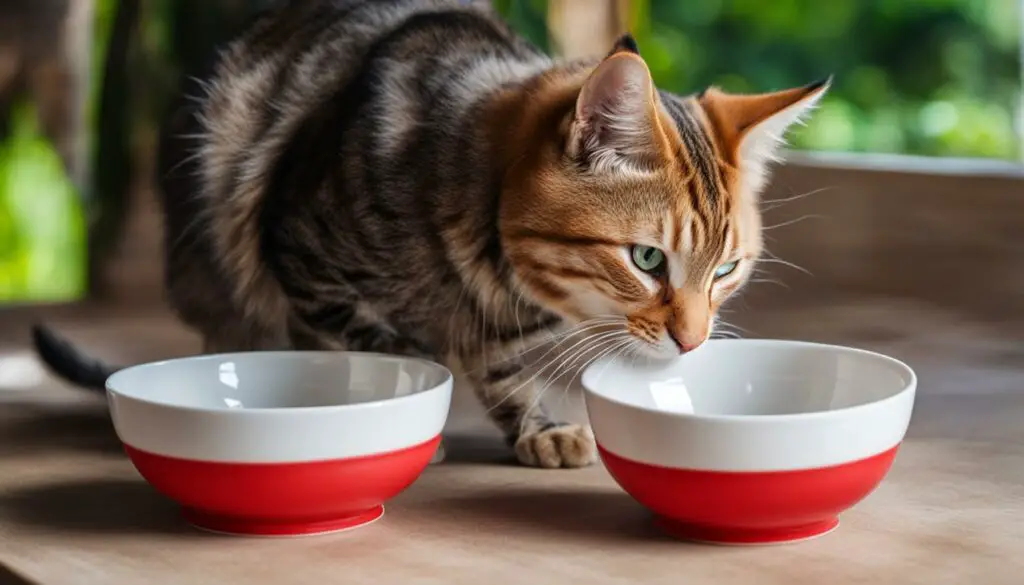
Table: Comparison of Pet Bowl Materials
| Bowl Material | Allergy Risk | Hygiene |
|---|---|---|
| Ceramic | Low | Easy to clean |
| Glass | Low | Easy to clean |
| Plastic | Potential allergies | Requires regular cleaning |
| Stainless Steel | Potential allergies | Requires regular cleaning |
The Role of Veterinarians in Managing Skin Conditions in Pets
When it comes to managing skin conditions in pets, veterinarians play a crucial role in providing the necessary expertise and guidance. They have the knowledge and experience to accurately diagnose the underlying causes of skin conditions, such as feline acne or allergies, and develop effective treatment plans tailored to each individual pet’s needs.
Veterinarians utilize various diagnostic tools, including physical examinations, laboratory tests, and imaging technology, to identify the root cause of the skin condition. Once the diagnosis is made, they can prescribe appropriate medications, such as topical creams or oral medications, to alleviate symptoms and promote healing. They also provide guidance on proper skincare routines, including bathing and grooming practices, to maintain the health of the pet’s skin.
Prevention is another crucial aspect of managing skin conditions, and veterinarians can offer valuable insights and recommendations. They can provide advice on nutrition, recommending specific diets or food supplements that support skin health. They can also educate pet owners on environmental factors that may contribute to skin problems, such as allergens or irritants, and suggest preventive measures to minimize exposure.
In addition to diagnosis, treatment, and prevention, veterinarians emphasize the importance of routine check-ups for pets with skin conditions. Regular visits allow for monitoring and early detection of any changes or recurrence of skin problems. Veterinarians can adjust treatment plans or recommend further interventions as necessary, ensuring the ongoing health and well-being of the pet.
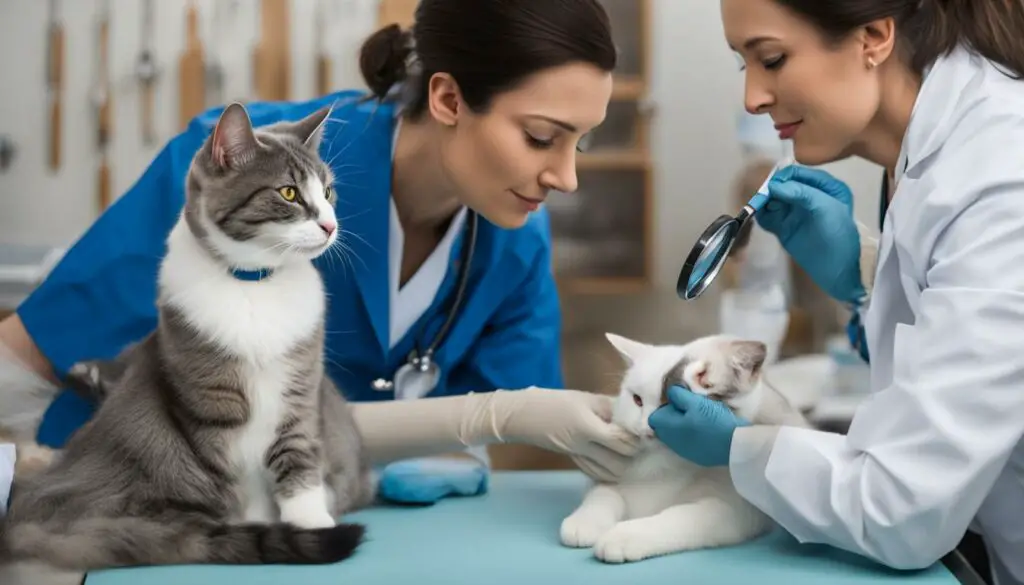
The Importance of Veterinary Care
“Veterinary care is vital in managing skin conditions in pets. Veterinarians have the expertise to accurately diagnose underlying causes, provide effective treatment plans, and offer guidance on prevention and routine care. Regular check-ups allow for ongoing monitoring and intervention as needed, ensuring the health and well-being of our beloved pets.”
In summary, veterinarians play a critical role in managing skin conditions in pets. Their expertise in diagnosis, treatment, prevention, and routine care is essential for addressing skin problems effectively. By working closely with a veterinarian, pet owners can ensure that their furry friends receive the best possible care for their skin health.
Conclusion
In conclusion, maintaining your cat’s health and managing skin conditions like feline acne are crucial for their overall well-being. Choosing the right cat food and food bowls can play a significant role in preventing allergies and skin problems. Switching from plastic to ceramic or glass bowls and cleaning them regularly can help minimize the risk of skin issues.
However, if your cat continues to experience skin conditions or if they worsen, it is essential to seek veterinary care. A veterinarian can accurately diagnose the underlying causes, provide appropriate treatment options, and prescribe medications if necessary. They can also offer guidance on preventing future occurrences and recommend holistic approaches to support your cat’s overall health.
Remember, prioritizing your cat’s health and seeking professional veterinary care are key in effectively managing and preventing skin conditions. By doing so, you can ensure that your furry friend leads a happy and healthy life.
FAQ
What is feline acne?
Feline acne is a common skin condition that affects cats, primarily around the chin and lip margins.
What causes feline acne?
The exact cause of feline acne is unknown, but it is believed to be triggered by factors such as increased production of sebum, viral infection, allergies, and contact hypersensitivity.
What are the signs of feline acne?
The signs of feline acne include thick, red, and crusty skin on the chin, visible clogged hair follicles, and the possibility of bacterial infections.
How is feline acne treated?
Treatment for feline acne should be provided by a veterinarian and may include shaving the affected area, cleaning with antiseptic solutions, lancing and draining abscesses, and the use of topical and/or oral medications.
Can feline acne be prevented?
Feline acne can be prevented by maintaining good grooming habits, changing food and water bowls, controlling allergies, and long-term topical therapy.
What are the non-parasitic causes of otitis and ear masses in cats?
Non-parasitic causes of otitis and ear masses in cats include food allergies, atopy, nasopharyngeal polyps, and otic neoplasia.
What is the underlying cause of feline acne?
Feline acne is an idiopathic disorder that is thought to be caused by underlying seborrhea, abnormal sebum production, viral infections, stress, chin trauma, and allergies.
What is allergic dermatitis in cats?
Allergic dermatitis in cats is a pruritic skin condition that can be caused by flea allergy dermatitis, food intolerance or hypersensitivity, and atopy.
Can plastic food bowls cause allergies in cats?
While scientific evidence regarding plastic allergies in cats specifically is limited, plastic and stainless steel bowls have been associated with the development of feline acne or chin acne.
How can chin acne be prevented and managed?
Chin acne can be prevented and managed by switching from plastic to ceramic or glass bowls, cleaning the bowls regularly, and using benzoyl peroxide wipes for mild cases. Veterinary treatment may be necessary for more severe cases.
Are there potential allergies in cats and dogs?
Yes, cats and dogs can have allergies to various materials, including plastic and stainless steel bowls. Ceramic or glass bowls are often recommended as safer alternatives.
How important is choosing the right bowls for your pet’s health?
Choosing the right bowls for your pet’s health is crucial to minimize the risk of allergies and skin problems. Ceramic bowls and glassware are generally considered safer options compared to plastic or stainless steel.
What is the role of veterinarians in managing skin conditions in pets?
Veterinarians play a crucial role in diagnosing, treating, and preventing skin conditions in pets. They can provide guidance, prescribe medications, and offer holistic approaches to support overall pet health and wellbeing.

